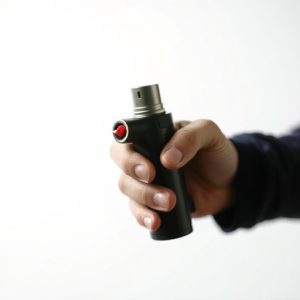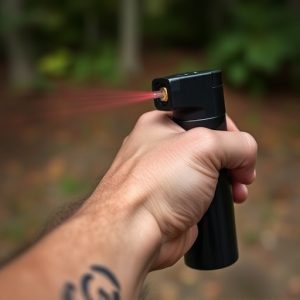Mastering Pepper Spray Safety: Treatment, Law, and Handling for Law Enforcement
TL;DR:Pepper spray exposure requires immediate action. For skin or clothing contact, rinse with larg…….
TL;DR:
Pepper spray exposure requires immediate action. For skin or clothing contact, rinse with large amounts of water for 15 minutes. For eye exposure, flush with clean water for 10-15 minutes while lifting lower eyelids. Seek medical attention if symptoms persist, especially for respiratory issues. Law enforcement should follow strict protocols: secure storage, de-escalation techniques, thorough documentation, and prompt treatment for exposed officers and bystanders to maintain legal standards and public safety.
Riot control agents, including pepper spray, are powerful tools employed by law enforcement to manage crowd control. However, their misuse or accidental exposure can lead to severe health consequences for both officers and civilians. This article explores the intricacies of riot control agents, offering insights into their types, effects, and safe handling practices. We also delve into medical treatments for pepper spray irritation and legal considerations, providing essential guidelines on how to manage and treat exposure effectively.
- Understanding Riot Control Agents: Types and Their Effects
- Immediate Steps After Pepper Spray Exposure
- Medical Treatment for Pepper Spray Irritation
- Legal Considerations for Law Enforcement Using Pepper Spray
- Best Practices for Safe Handling and Storage of Riot Control Agents
Understanding Riot Control Agents: Types and Their Effects
Riot control agents are a crucial tool in law enforcement, designed to manage and disperse large crowds or individuals involved in civil unrest. These chemical compounds come in various forms, each with distinct effects on the human body. One of the most common types is pepper spray, which contains capsaicin, the active ingredient found in chili peppers. When deployed, it irritates the eyes, nose, and respiratory system, leading to temporary blindness, coughing, and difficulty breathing.
Knowing how to treat exposure to these agents is vital for both officers and bystanders. In case of pepper spray contact with skin or clothing, immediate rinsing with large amounts of water for at least 15 minutes can help wash away the chemical. For eye exposure, flushing with clean water for at least 10-15 minutes, while gently lifting lower eyelids, can alleviate irritation and discomfort. Seeking medical attention is recommended if symptoms persist or worsen, ensuring proper care and mitigating potential long-term effects of riot control agent exposure.
Immediate Steps After Pepper Spray Exposure
After exposure to pepper spray, the immediate response is crucial for mitigating its effects. If a person comes into contact with pepper spray, they should immediately move to a safe, open area away from others to prevent spreading the irritant. This quick action can help reduce the impact on both the exposed individual and bystanders.
In terms of how to treat pepper spray exposure, removing contaminated clothing and washing affected areas with mild soap and water is essential. This process helps flush out the irritants. Applying a cold compress or ice pack wrapped in a towel can provide some relief from pain and discomfort. It’s important to stay calm, as panicking may intensify the sensation of burning or stinging. Seeking medical attention is advised if symptoms persist or worsen, especially for individuals with pre-existing respiratory conditions.
Medical Treatment for Pepper Spray Irritation
Pepper spray, a common riot control agent used by law enforcement, can cause significant irritation and discomfort for those exposed. When dealing with pepper spray exposure, prompt medical treatment is essential to mitigate symptoms and ensure safety. The first step is to immediately flush the affected area with water for at least 15 minutes to dilute and remove the irritant chemicals. This action is crucial in preventing further absorption of the spray into sensitive tissues.
After initial flushing, individuals should seek fresh air and avoid rubbing or scratching the irritated skin, which can exacerbate the situation. Medical professionals may recommend eye washes or irrigation for eyes exposed to pepper spray, as it can cause severe irritation and temporary blindness. Additionally, over-the-counter antihistamines and pain relievers may help alleviate symptoms like itching, tearing, and respiratory distress. It’s important to remember that in cases of severe exposure, emergency medical care should be sought immediately.
Legal Considerations for Law Enforcement Using Pepper Spray
Law enforcement agencies must adhere to strict legal considerations when employing riot control agents like pepper spray. The use of such substances is regulated by a web of federal and state laws, aimed at balancing public safety with individual rights. Officers are required to receive specific training on when and how to deploy pepper spray, ensuring minimal harm to bystanders and respecting the constitutional rights of individuals.
In case of exposure, understanding How to Treat Pepper Spray Exposure becomes paramount. This includes implementing de-escalation techniques, providing medical aid where necessary, and documenting the incident thoroughly. Effective treatment involves removing contaminated clothing, irrigating the eyes and respiratory tract, and seeking professional medical advice promptly. Such precautions not only mitigate risks but also demonstrate a responsible approach to maintaining public order while upholding legal standards.
Best Practices for Safe Handling and Storage of Riot Control Agents
When handling riot control agents, law enforcement personnel must adhere to stringent safety protocols. These best practices begin with proper storage, ensuring that these chemicals are kept in secure, labeled containers, stored away from heat sources and direct sunlight. It’s crucial to maintain a controlled environment, keeping them well-ventilated and out of reach of unauthorized individuals.
In case of exposure, knowing how to treat pepper spray is vital. If an officer comes into contact with the agent, they should immediately move to a safe area, wash their face and eyes thoroughly with clean water for at least 15 minutes, and remove any contaminated clothing. Medical attention should be sought if symptoms persist or worsen, as prompt treatment can significantly alleviate discomfort and potential long-term effects.
Riot control agents, particularly pepper spray, are powerful tools in law enforcement, but their use comes with significant legal and ethical considerations. Understanding the types of agents, their effects, and implementing best practices for handling and storage is crucial. In cases of exposure, prompt medical treatment and knowing how to manage the situation are essential. By adhering to these guidelines, law enforcement can effectively maintain public safety while ensuring the well-being of both officers and citizens, thereby fostering a more secure and harmonious environment. Additionally, understanding legal implications empowers officers to use these agents responsibly, addressing potential issues related to excessive force and civil liberties.


